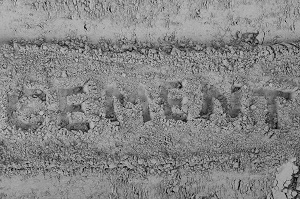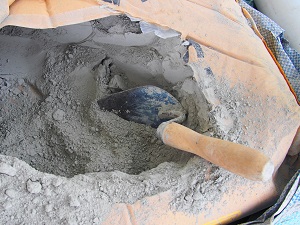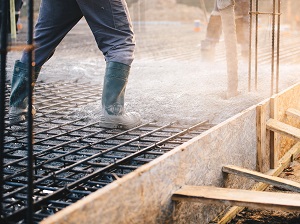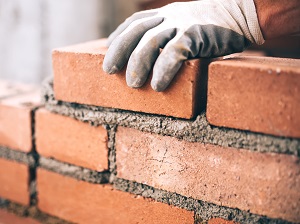Workers using or supervising the use of cement should know the health hazards, understand the risks, and follow safe working procedures necessary to limit harmful exposure.

Although the terms cement and concrete often are used interchangeably, cement (also known as portland cement) is actually an ingredient of concrete. Cement makes up about 10 to 15% of the overall concrete mix when added to sand and gravel or crushed stone along with water.
After the concrete is poured, the cement and water begin to harden and bind the mixture. This process continues for years as the concrete product becomes even stronger as it ages, due to the chemical properties of the cement.
Cement is an ingredient that can be found in these materials:
- concrete
- mortar
- plaster
- grout
- stucco
- terrazzo
OSHA 1926 Subpart Q provides the specific standards for concrete including requirements for equipment and tools, cast-in-place concrete, formwork, precast concrete, lift-slab operations and masonry construction.
Anyone who works with cement, or products that contain cement, is at risk of developing mild to severe skin problems, eye irritation and symptoms of respiratory distress. Wet cement can damage the skin because it is caustic, abrasive, and absorbs moisture. It may also contain trace amounts of hexavalent chromium, a toxin harmful to the skin.

Wet cement can cause caustic burns on the skin, sometimes referred to as cement burns. Continuous contact between the skin and wet concrete allows alkaline compounds to penetrate and burn the skin. Skin contact with wet cement that is not washed off immediately can cause inflammation of the skin, referred to as dermatitis, with symptoms that might include itching, redness, swelling, blisters, scaling or other changes to the skin.
Cement burns may result in blisters, dead or hardened skin, or black or green skin. In severe cases, these burns may extend to the bone and cause disfiguring scars or disability. When working with cement, do not rely on pain or discomfort as the sign to get washed off!
Wash areas of the skin that come into contact with wet or dry cement in clean, cool water as soon as possible. Use a pH-neutral or slightly acidic soap. Employees working with wet cement who begin to experience skin problems, even if they seem minor, are advised to see a health care professional for evaluation. Early diagnosis and treatment can help prevent chronic skin problems.
By the time a person becomes aware of a cement burn, much of the damage has already happened, and cement burns can get worse even after there is no longer skin contact with the cement. Any person experiencing a cement burn should see a health care professional immediately.
Dry cement is less hazardous to the skin because it is not as caustic as wet cement. However, be aware of cement dust released during bag dumping or concrete cutting. When moisture from sweat or wet clothing reacts with cement dust it can form a caustic solution that will burn the skin. Only mix dry cement in well-ventilated areas.
Some workers may develop allergic skin reactions to the hexavalent chromium in cement which can produce symptoms ranging from a mild rash to severe skin ulcers. Hexavalent chromium can also cause a respiratory allergy called occupational asthma with symptoms like wheezing and difficulty breathing. It is possible to work with cement for years without any allergic reaction but then discover the skin or respiratory allergy as it develops suddenly. These allergies should be taken seriously as they usually get worse over time and can result in severe reactions.

When emptying bags of cement, workers may be inhaling high levels of dust which can irritate the nose and throat causing breathing difficulties. Exposure to airborne dust may cause immediate or delayed irritation of the eyes. Depending on the level of exposure, effects may range from redness to chemical burns and blindness.
OSHA has established a permissible exposure limit (PEL) to address the inhalation hazards of working with dry portland cement. (See OSHA 1926.55) Employers must limit airborne exposure to portland cement to 15 milligrams per cubic meter (mg/m3) of air for total dust and 5 mg/m3 for respirable dust. When cement dust cannot be avoided or may exceed the PEL, suitable respiratory protection (such as a P, N or R 95 respirator) should be worn.
Wearing proper PPE, including gloves, boots and eye protection, is critical when working with materials that contain cement, like wet concrete.
Butyl or nitrile gloves (rather than cotton or leather gloves) are frequently recommended for caustic materials such as cement. Gloves should be alkali-resistant. Use only well-fitting gloves that are not loose enough to let the cement inside. Glove liners can be used for added comfort. Before putting on gloves, wash your hands and dry them with a clean cloth or paper towel.
Before removing reusable gloves, clean them thoroughly by rinsing or wiping them off. Wash your hands every time you remove your gloves. Always dispose of contaminated or worn-out gloves. Don’t wash your hands with water from buckets used for cleaning tools.

For additional protection, wear a long sleeve shirt and tape the sleeves to the gloves to prevent wet materials from getting inside the gloves. Wear sturdy, waterproof boots that are high enough to prevent wet cement from getting inside.
Where mixing, pouring, or other cement work activities may endanger the eyes, suitable eye protection must be worn. At minimum, safety glasses with side shields or goggles should be worn. Avoid wearing contacts when handling cement products.
When kneeling on fresh concrete, use a dry board or waterproof kneepads to protect knees from the wetness that can soak through fabric. Change out of any work clothes that become soaked with wet cement and keep dirty work clothes separate from your street clothes.
OSHA Standard 1926.51(f)(1) The employer shall provide adequate washing facilities for employees engaged in the application of paints, coating, herbicides, or insecticides, or in other operations where contaminants may be harmful to the employees. Such facilities shall be in near proximity to the worksite and shall be so equipped as to enable employees to remove such substances.
Sanding, grinding or cutting concrete releases dust that contains crystalline silica. Prolonged or repeated exposure to silica dust can lead to silicosis, a disabling lung disease.


.jpeg)
